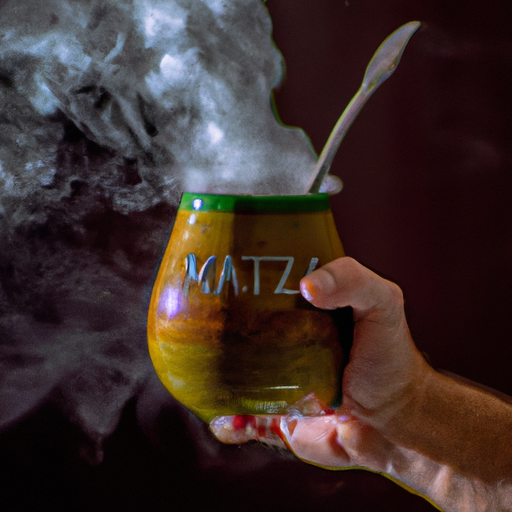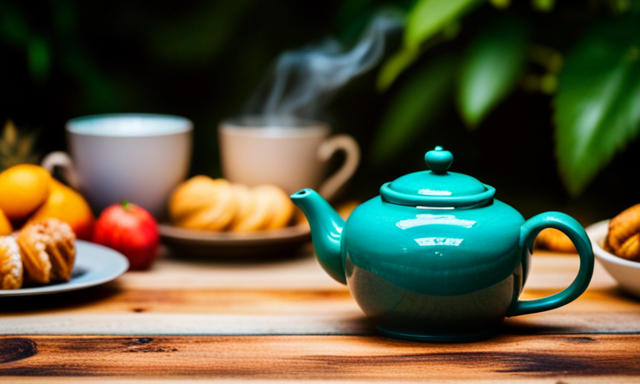I’ve always been captivated by the history of various drinks and their journey to becoming essential elements of our daily routines. Yerba mate, a traditional beverage from South America, has particularly drawn my attention due to its rising global popularity in recent times.
As I delved deeper into its history, I discovered a rich cultural heritage and a fascinating story of discovery and expansion. Yerba mate originated in South America, where it was first consumed by indigenous communities thousands of years ago. The drink has played an important role in their social, cultural, and medicinal practices for centuries.
Today, yerba mate continues to be a beloved beverage among people from all walks of life, with many touting its health benefits and unique flavor profile. In this article, we will explore the history of yerba mate – from its discovery by the Guaranàpeople to its global popularity today – as well as traditions surrounding this special drink and the industry that supports it.
Key Takeaways
- Yerba mate originated in indigenous communities in present-day Paraguay and Brazil.
- The Guarani people played a significant role in the history and cultivation of yerba mate.
- Yerba mate is a traditional South American beverage with social, cultural, and medicinal significance.
- Yerba mate remains an important symbol of unity, hospitality, and friendship in many Latin American countries.
The GuaranàPeople
The Guaranà people, indigenous to South America, played a significant role in the history and cultivation of yerba mate. Yerba mate consumption has been an integral part of their culture for centuries. The Guaranà people were the first to discover the energizing and medicinal properties of yerba mate. They believed that it had the power to heal various ailments and enhance mental clarity.
In Guaranà culture, sharing yerba mate was a symbol of friendship and hospitality. It was customary for families and friends to gather around a communal gourd and share a drink together. This tradition is still prevalent in South American countries today, where yerba mate continues to be consumed socially.
The Guaranà people were responsible for cultivating yerba mate trees and developing methods for preparing the leaves for consumption. Their knowledge about the plant’s properties was passed down from generation to generation, contributing to its widespread use across South America.
As we move onto discussing how yerba mate was discovered by Europeans, it becomes apparent how important Guaranà culture was in shaping its history.
Discovery of Yerba Mate
Wow, you won’t believe how insanely lucky the indigenous people were when they stumbled upon this super energizing and delicious beverage! According to the discovery story, it all began when an indigenous Guaranà man was wandering through the forest in search of his missing wife.
He found her sitting under a tree drinking a strange liquid from a gourd with a metal straw. Intrigued by what she was drinking, he decided to try it himself. That’s how he discovered yerba mate!
The Guaranà people quickly realized that yerba mate had numerous benefits beyond its taste. They drank it to boost their energy levels and stay alert during long hunting trips or important tribal meetings. As a result, yerba mate became an integral part of their indigenous culture and traditions.
In fact, they even developed complex social rituals around sharing the drink. This discovery not only made life easier for the Guaranà people but also introduced a new source of income for them. The popularity of yerba mate soon spread beyond their tribe, and other South American cultures started trading with them for this precious commodity.
It’s amazing to think about how one accidental discovery can have such far-reaching implications on both individuals and societies as a whole! Speaking of which, let’s delve into another fascinating aspect of yerba mate: its medicinal properties.
Medicinal Properties
You’re in luck because yerba mate has a plethora of medicinal properties that can benefit your health and well-being. For centuries, yerba mate has been used as a traditional remedy to treat various ailments. It contains antioxidants, vitamins, minerals, and caffeine, which work together to provide numerous health benefits. Yerba mate’s medicinal properties have been scientifically proven through research studies.
One of the major benefits of drinking yerba mate is its ability to boost energy levels and improve mental focus. The caffeine present in yerba mate provides an immediate source of energy without the jitters commonly associated with coffee consumption. Additionally, yerba mate contains theobromine and theophylline, which help to relax muscles and improve blood flow, thereby increasing mental clarity.
Apart from being an energizing drink, yerba mate is also known for its anti-inflammatory properties. Yerba Mate Medicinal Benefits include reducing inflammation caused by conditions such as arthritis, allergies, or diabetes. Moreover, it can help boost immunity since it contains compounds that stimulate white blood cell production.
Yerba Mate Medicinal Benefits are many, including improving physical performance, boosting immunity, and promoting mental clarity, among others. These Traditional Remedies have been used for centuries in South America, where it originated from before spreading across the world due to its numerous health benefits.
As we delve into social and cultural aspects of this drink next, you’ll learn how it’s enjoyed among different communities around the world!
Social and Cultural Drink
As I delve into the social and cultural aspects of yerba mate, I can see how it has become a significant part of modern society. It’s a drink that is enjoyed among various communities worldwide, ranging from South America to Europe and Asia. In some countries, it’s even gained popularity as an alternative to coffee or tea.
Yerba mate holds great cultural significance for many people who’ve grown up drinking it with family and friends. In Argentina, sharing mate is an essential part of their social culture. The act of passing around the gourd filled with yerba mate is seen as a symbol of friendship and unity.
Similarly, in Paraguay, they’ve made the drink an integral part of their daily routine. They carry thermoses filled with hot water everywhere they go so that they can enjoy mate anytime.
With its growing popularity worldwide, yerba mate has expanded beyond its traditional roots in South America. It has now become more accessible in North America and Europe due to its health benefits and unique flavor profile.
As we move on to discussing the expansion of yerba mate further, let’s take a closer look at how this beverage found its way outside Latin America.
Expansion of Yerba Mate
As I continue to explore the history of yerba mate, I’m fascinated by its expansion beyond its origin in South America.
One key point is the introduction of this beverage to new audiences outside of traditional cultural groups.
Additionally, it’s interesting to observe how yerba mate has spread across South America and become a staple in many countries’ diets.
The evidence shows that this drink has made a significant impact on various societies throughout history, and it continues to be enjoyed today by people worldwide.
Introduction to New Audiences
Did you know that over 90% of the world’s yerba mate is produced in South America, where it originated? As a popular beverage in South America, yerba mate has gained a lot of cultural significance and is enjoyed as a social drink among friends and family.
However, with the expansion of yerba mate production, there has been an introduction to new audiences around the world. New audience engagement has played a significant role in spreading awareness about yerba mate. With its numerous health benefits and unique taste profile, people from various cultures have been curious to try this traditional beverage. Additionally, companies have begun incorporating yerba mate into their products such as energy drinks and tea blends which appeal to different markets.
With this introduction to new audiences comes an appreciation for the cultural significance behind this beverage and its importance in South American history. Moving forward, let’s explore how yerba mate spread across South America.
Spread Across South America
By exploring the historical routes and cultural significance of yerba mate, one can gain a deeper understanding of how this traditional beverage spread across South America.
The origins of yerba mate can be traced back to indigenous communities in present-day Paraguay and Brazil who used it as a medicinal plant. As these communities interacted with other tribes, they shared their knowledge about the properties and benefits of yerba mate.
The cultural significance of yerba mate grew as it became an integral part of social customs and rituals among indigenous groups. With the arrival of European colonizers, yerba mate began to spread beyond its original borders and was eventually embraced by different cultures throughout South America. Today, it remains an important symbol of unity, hospitality, and friendship in many Latin American countries.
Furthermore, the historical significance of yerba mate cannot be overlooked given its role in shaping the region’s economy and trade relationships. The cultivation and exportation of yerba mate played a major part in regional commerce during times when European powers were vying for control over resources in South America.
This history has contributed to making yerba mate a staple not only within local culture but also worldwide due to its unique flavor profile and cultural importance. As we move into discussing global popularity for yerba mate, it is important to recognize that its roots remain firmly planted in South American culture and history.
Global Popularity
I find it fascinating how yerba mate, a drink that originated in South America, has gained such worldwide popularity.
It’s interesting to see how the availability of yerba mate has expanded beyond its traditional market and is now consumed in many parts of the world.
I’m also curious about what factors have contributed to the rise in popularity of this unique beverage.
Availability in Different Parts of the World
Yerba mate is widely available in South America, but what about other parts of the world? While it may not be as popular elsewhere, yerba mate can still be found in many countries around the globe. Its global distribution has expanded as more people become aware of its cultural significance and health benefits.
In North America, yerba mate can be found in specialty stores or online markets. It’s also becoming increasingly popular in Europe, particularly in countries like Germany and Spain where there are large populations of South American immigrants.
In Asia, yerba mate is gaining traction in places like Japan and South Korea where there is a growing interest in healthy lifestyle choices. As we explore reasons for its rise in popularity, we’ll see just how much this traditional drink has come to influence cultures all over the world.
Reasons for Its Rise in Popularity
You might be wondering why yerba mate has become so popular in recent years, but the reasons behind its rise are actually quite fascinating.
One major reason is the health benefits associated with drinking yerba mate. Studies have shown that it contains high levels of antioxidants and nutrients, which can improve digestion, boost energy levels, and even lower the risk of certain diseases like heart disease and cancer. Additionally, yerba mate contains caffeine and theobromine, two stimulants known for their ability to increase mental alertness and focus.
Another reason for yerba mate’s popularity is its cultural significance. Originating in South America, yerba mate has been a part of traditional ceremonies and social gatherings for centuries. It has deep roots in indigenous cultures and is often shared among friends as a sign of hospitality.
As more people around the world become interested in exploring different cultures through food and drink, yerba mate offers an opportunity to connect with this rich history.
As we delve into the next section about ‘yerba mate traditions’, we’ll see how these cultural roots continue to shape the way people enjoy this beloved beverage today.
Yerba Mate Traditions
I find it fascinating to learn about the customs and practices associated with yerba mate, a beverage that has been an integral part of South American culture for centuries.
One interesting aspect is the sharing and drinking etiquette, which varies depending on the region and social setting. For example, some people prefer to drink mate out of a gourd with a metal straw called a bombilla while others use a wooden or ceramic vessel.
Understanding these traditions can help us appreciate the cultural significance of yerba mate and enjoy it in its intended way.
Customs and Practices Associated with Yerba Mate
From sharing a single cup among friends to passing the mate gourd with your right hand, the customs and practices associated with this traditional South American beverage are steeped in cultural significance. Drinking yerba mate is more than just sipping on a hot brew; it’s about community and connection.
Here are some of the yerba mate customs that one might encounter while drinking:
-
Passing the mate gourd with your right hand: This custom symbolizes respect and friendship. It’s said that passing the gourd with your left hand could bring bad luck.
-
Drinking from a communal straw (or bombilla): Sharing a straw may seem unhygienic to some, but it’s all part of the tradition. The idea behind using a communal straw is to promote inclusivity and create a sense of unity.
-
Refilling the gourd for others: If you’re serving yerba mate, it’s customary to refill the gourd until everyone has had their fill.
-
Saying ‘gracias’ after finishing: After taking your last sip, it’s polite to say ‘gracias’ (thank you) as an appreciation for being served.
-
Not touching or moving someone else’s bombilla: Each person has their own bombilla (straw), which should not be touched or moved by anyone else.
These yerba mate customs contribute to making drinking yerba mate an enjoyable experience. Understanding these customs can help foreigners appreciate and participate in this important aspect of South American culture.
Now, let’s move on to discussing sharing and drinking etiquette in more detail without any delay.
Sharing and Drinking Etiquette
Get ready to learn about the proper sharing and drinking etiquette when it comes to enjoying yerba mate. Yerba mate is not just a drink, but also a symbol of friendship and hospitality in many South American countries. This means that there are certain customs and practices associated with its consumption, particularly when shared among friends or family.
Drinking rituals vary depending on the region, but some common etiquette guidelines include using a traditional gourd (called a ‘mate’) and straw (called a ‘bombilla’), which are typically passed around clockwise. It’s important to never touch the bombilla with your hands or move it around in the gourd, as this can disrupt the flavors and aromas of the yerba mate.
Additionally, it’s considered impolite to decline an offer of yerba mate from someone who is sharing their drink with you. These rules may seem strict, but they help ensure that everyone is able to enjoy yerba mate together in harmony.
As we wrap up our discussion on sharing and drinking etiquette, let’s shift our focus towards another aspect of yerba mate – its industry.
Yerba Mate Industry
As I delve into the subtopic of Yerba Mate Industry, I can’t help but analyze its economic impact, production, and distribution.
The industry has a significant contribution to the economy of South America, particularly in countries like Argentina, Brazil, and Paraguay.
The production process involves several steps from planting to packaging and distribution across the globe.
Economic Impact of Yerba Mate
The economic impact of yerba mate can be seen in the significant increase in employment opportunities and revenue for countries that produce and export this popular beverage. Yerba mate production requires sustainable practices which have led to the creation of jobs for local farmers, harvesters, and processors.
In addition, the global demand for yerba mate has increased steadily over the past few years, resulting in a boost in revenue for exporting countries. Some market trends that have contributed to the growth of yerba mate include an increasing interest in natural and organic products, as well as a rising awareness of its health benefits. Moreover, yerba mate has gained popularity among coffee drinkers who are looking for alternative sources of caffeine. These factors have helped position yerba mate as a promising industry with room for continued growth.
As we move into discussing production and distribution, it is important to note that the economic impact of yerba mate extends beyond its direct effects on employment and revenue. The success of this industry also has ripple effects on related businesses such as transportation and packaging suppliers.
Production and Distribution
Let’s explore how yerba mate is produced and distributed around the world. Production techniques for yerba mate have evolved over time, but traditional methods are still used in some parts of South America. The process involves harvesting the leaves from the yerba mate tree, drying them, and then aging them to enhance their flavor. Modern production techniques involve using machinery to speed up the process and produce consistently high-quality yerba mate.
Historical trade routes played a significant role in the distribution of yerba mate around the world. Yerba mate was first consumed by indigenous tribes in South America before being introduced to European settlers who exported it to other parts of the world. Today, Argentina is one of the largest producers and exporters of yerba mate, with its product being sold worldwide. Other countries such as Brazil and Paraguay also produce and export yerba mate using modern production techniques that ensure consistent quality for consumers.
Frequently Asked Questions
What is the production process for making yerba mate?
Alright, let’s talk about the production process for making yerba mate. First things first, we gotta harvest the leaves from the yerba mate plant using some pretty advanced harvesting techniques.
Once we’ve got our leaves, they’re dried and then chopped up into small pieces. Next comes the roasting process, where the chopped up leaves are heated until they’re nice and toasty. After that, the leaves are packed into bags or containers and sent off to be sold.
Now, I know what you might be thinking – why do people go through all this trouble just to make a cup of tea? Well, it turns out that yerba mate has a lot of cultural significance in countries like Argentina and Paraguay.
It’s often shared during social gatherings as a way of bringing people together and strengthening bonds. Plus, it’s got a whole bunch of health benefits too! So yeah, while it might seem like a lot of work at first glance, there’s definitely something special about this unique drink.
How long has yerba mate been consumed by humans?
Yerba mate has a rich history and cultural significance that dates back to ancient times. It’s believed that the indigenous Guarani people of South America were the first to discover the rejuvenating qualities of yerba mate leaves. They would brew the leaves into a tea-like beverage.
Over time, this practice spread throughout South America, becoming an integral part of daily life for many cultures. The popularity of yerba mate continues to grow worldwide due to its numerous health benefits and energizing effects.
Its long-standing tradition in countries like Argentina and Uruguay has led to it being recognized as an important symbol of national identity and pride. Overall, the history and cultural significance of yerba mate demonstrate its enduring importance as a beloved beverage enjoyed by millions around the world.
What are the environmental impacts of growing yerba mate?
As someone who’s interested in the environmental impacts of food production, I’ve researched the sustainable practices surrounding yerba mate cultivation.
While yerba mate has a long history of consumption by humans – with evidence suggesting indigenous groups in South America were consuming it as early as 3000 years ago – concerns have been raised about the impact of modern farming practices on the environment.
Yerba mate is typically grown in regions with high biodiversity, and deforestation can be a major concern. However, there are efforts being made to promote sustainable practices, such as shade-grown yerba mate, which preserves the natural ecosystem and reduces carbon emissions.
Additionally, companies are working to implement fair labor standards for workers involved in harvesting and processing yerba mate.
Overall, while there are certainly challenges associated with growing yerba mate sustainably, there are also promising developments that suggest a brighter future for this beloved beverage.
Are there any negative health effects associated with drinking yerba mate?
I’ve researched the potential negative health effects of drinking yerba mate, and it turns out that the idea that it causes cancer is largely a myth.
While some studies have found a correlation between heavy consumption of yerba mate and an increased risk of certain cancers, such as esophageal cancer, most experts agree that these results are likely due to other lifestyle factors among heavy drinkers.
In fact, there is evidence to suggest that yerba mate may actually have some health benefits, including aiding in weight loss due to its thermogenic properties.
So while it’s always important to monitor your intake of any substance, I feel confident in enjoying my occasional cup of yerba mate without worrying about negative health consequences.
How is yerba mate traditionally consumed in different regions around the world?
When it comes to yerba mate, traditional preparations and cultural significance vary greatly depending on the region.
In South America, where yerba mate originated, it is often consumed in a communal setting using a gourd and bombilla (a metal straw with a filter) to share the drink among friends. The preparation process involves filling the gourd with loose leaf yerba mate, adding hot water (not boiling), and sipping through the bombilla.
In other parts of the world, such as Syria and Lebanon, yerba mate is mixed with sugar and served cold as a refreshing beverage during hot weather.
Regardless of how it’s prepared, there’s no denying that yerba mate holds great cultural significance for many communities around the world. From its use in social gatherings to its role as a symbol of hospitality, this beloved beverage has stood the test of time thanks to its rich history and unique flavor profile.
Conclusion
In conclusion, it’s fascinating to learn about the history and origins of yerba mate. The Guaranà people discovered the plant’s medicinal properties and used it as a social and cultural drink.
Yerba mate expanded in popularity throughout South America before becoming a global phenomenon. Today, we can enjoy yerba mate traditions such as sharing a gourd with friends or adding milk and sugar for a sweeter taste.
The yerba mate industry has also flourished, with various brands offering different blends and flavors. It’s clear that this ancient drink holds an important place in both traditional and modern culture.










